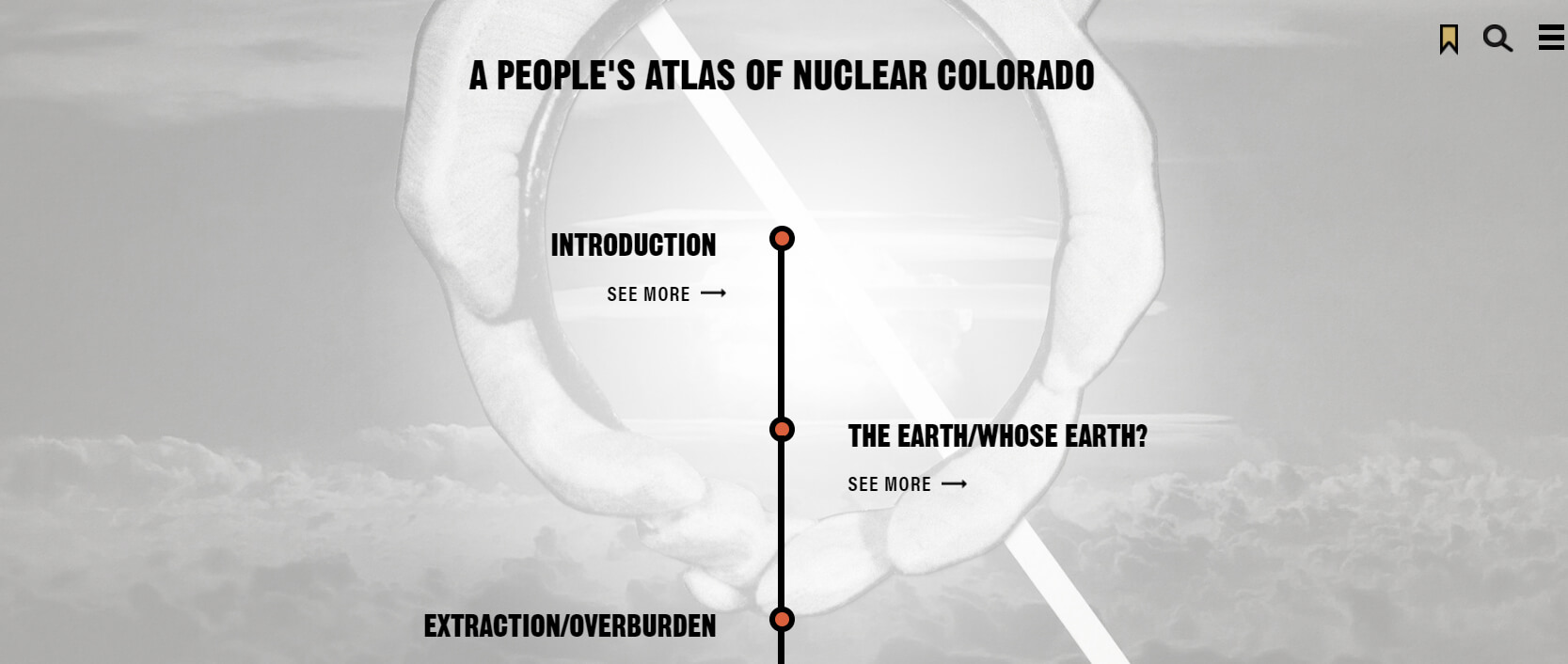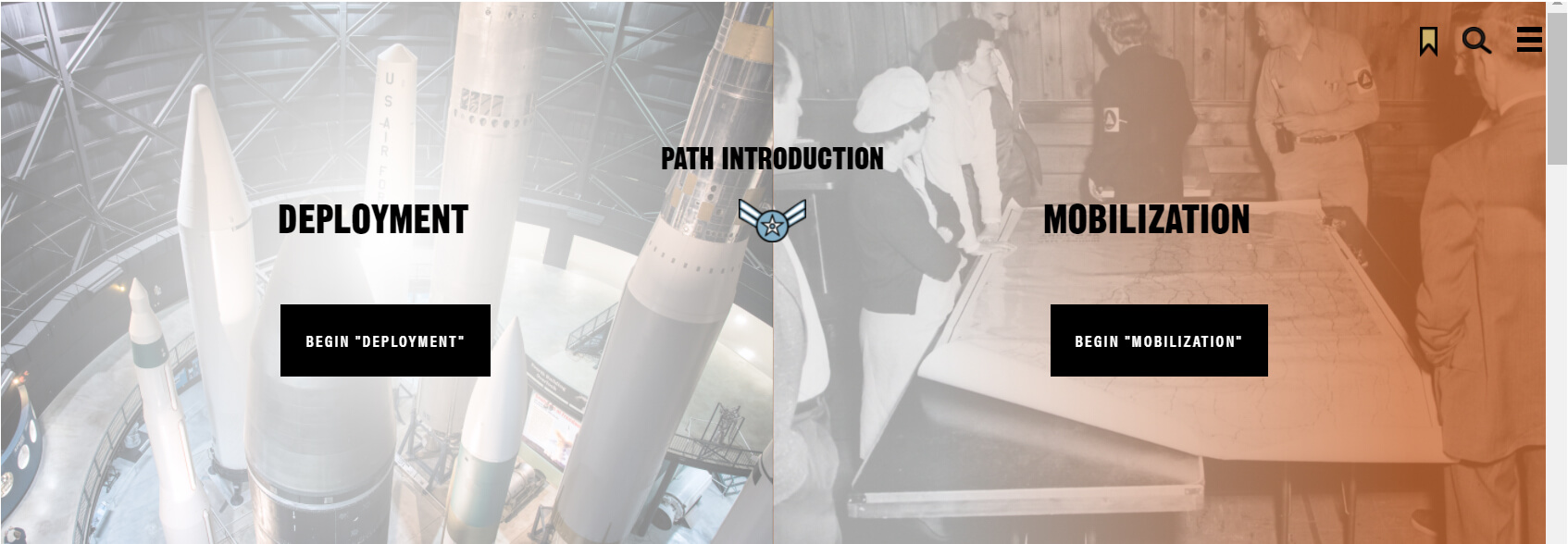A People’s Atlas of Nuclear Colorado
Shiloh Krupar and Sarah KanouseMarch 21, 2022 | Projects
A People’s Atlas of Nuclear Colorado is a digital public humanities project documenting and interpreting the sites, issues, policies, and cultures associated with the American nuclear weapons complex in its ninth decade. It operates in the tradition of the atlases and counter-maps developed by activist scholars and artists. With more than 40 contributors to date, the Atlas collects and cross-references many types of knowledge, affective registers, and forms of evidence. These include maps, photographs, and descriptions of major and minor nuclear sites; issue briefs offering historical and policy contexts; artworks responding to nuclear legacies; and scholarly essays connecting Colorado’s atomic histories to environmental justice, technoscientific practice, formations of nuclear citizenry, and political hegemony.
This heterogeneous collection of texts and artifacts implicitly resists the compartmentalization and black-boxing of military and industrial nuclear discourse. It allows the Atlas’s reader to move forward and backward in time, switch frames of references, and connect seemingly far-flung concepts. Significantly, many individual items appear multiple times in the Atlas, recombined with other materials as the context shifts. Trespassing bounded categories, entries may emerge in more than one path to confront and engage with the ontological uncertainties and temporary unboundedness of the nuclear condition itself.

Figure 1. Partial screenshot of the interface of A People’s Atlas of Nuclear Colorado. Courtesy of Sarah Kanouse and Shiloh Krupar.
Like printed atlases, A People’s Atlas of Nuclear Colorado is a reference work. Designed to be viewed on computer screens, it has a book-like quality allowing for both linear explorations of curated paths, as well as digitally enabled interactions like searchability and map navigation. As the prominent features of the interface, the paths act as narrative arcs that both employ and expand conventional, techno-positivist depictions of the nuclear fuel cycle. Popular illustrations of the fuel cycle depict idealized conditions, wherein all waste is fully reprocessable and nuclear activities occur in isolation from socio-political contexts and planetary ecologies. These renderings also foreground nuclear energy as separated from the possibility of weapons. The Atlas’s version of the fuel cycle refuses this ideology of separation and widens the frame to consider the material-geological processes, political processes, and social practices activated by the nuclear. For example, the path entitled “The Earth” — an exploration of the deep time geological processes that formed the Colorado Plateau — is a necessary stage preceding the human-driven processes of “Extraction.” The Atlas also encompasses path contents on “Mobilization” and “Deployment” that are typically absent from the more technically-focused, positivist renderings of the fuel cycle.

Figure 2. Screenshot of the “Deployment|Mobilization” pathway introduction, in A People’s Atlas of Nuclear Colorado. Courtesy of Sarah Kanouse and Shiloh Krupar.
Each stage of this expanded cycle is paired with what we call its “shadow side:” the uncontainable material, social, and political implications that together unfold at every stage of the fuel cycle itself. For example, the path “Exposure” is the shadow side of “Refining.” It explores worker and community vulnerability in the face of contamination, the inadequacy of safety and environmental protocols, and corresponding community efforts to take health care-related action. The “shadow” path should not, therefore, be considered the negative or inverse of the positivist path. Rather, it can be understood as the disavowed implications of nuclear technocracy and the improvisational organization of life pursued within and/or in spite of it.

Figure 3. Map view interface of A People’s Atlas of Nuclear Colorado. Courtesy of Sarah Kanouse and Shiloh Krupar.
The Atlas aspires to serve as a kind of civic infrastructure rooted in the complex geographies of Colorado. The state is a microcosm of the globally expansive U.S. nuclear complex, encompassing sites of extraction, resource processing, weapons production, and deployment. These activities have profoundly shaped Colorado’s present-day landscape and politics; and, when understood more holistically, link communities involved in distinct dimensions of the atomic. This geographically-bounded scope allows us to position local histories and on-the-ground experiences within entangled national and global forces. Narrowing the territorial focus of the nuclear weapons/energy complex to Colorado is, of course, reductive. It is, after all, a people’s atlas, not the people’s atlas. Its title and scope resist the tendency of the nuclear to be considered primarily through the spatial abstractions of international relations, where scales other than the nation-state barely register.

Figure 4. Screenshot of issue brief “Transporting Nukes” by Nareg Kuyumjian, in A People’s Atlas of Nuclear Colorado. Courtesy of Sarah Kanouse and Shiloh Krupar.
_________________________________________________________________
Sarah Kanouse (Northeastern University) is an artist and writer whose award-winning essay film Grassland (2019) addresses the deep histories of the missile and fracking fields of Colorado.
Shiloh Krupar (Georgetown University) is the author of Hot Spotter’s Report: Military Fables of Toxic Waste (U. Minnesota, 2013) and co-author of Deadly Biocultures: The Ethics of Life-making (U. Minnesota, 2019).
Together Kanouse and Krupar co-directed the National Toxic Land/Labor Conservation Service.
Published: 03/21/2022
